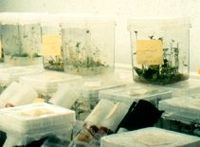
Photo from wikipedia
Several methods for sampling, culturing, and decontaminating donor grafts are available for cardiovascular tissue banks. Most of these protocols are not standardized, leaving tissue banks to adapt their microbiological procedures… Click to show full abstract
Several methods for sampling, culturing, and decontaminating donor grafts are available for cardiovascular tissue banks. Most of these protocols are not standardized, leaving tissue banks to adapt their microbiological procedures to their tissue processing routines. Effective microbiological testing and decontamination procedures are essential to ensure tissue quality and safety for human application. This review presents the different procedures currently available for microbiological testing in cardiovascular tissue banks. Impact statement Sterility testing is a critical issue in the recovery, processing, and release of tissue allografts. Contaminated allografts are often discarded, increasing costs, and reducing tissue stocks. Given these concerns, it is important to determine the most effective methodology for sterility testing. This work provides an overview of microbiological methods for sampling and culturing donor grafts for cardiovascular tissue banking.
Journal Title: Experimental Biology and Medicine
Year Published: 2018
Link to full text (if available)
Share on Social Media: Sign Up to like & get
recommendations!